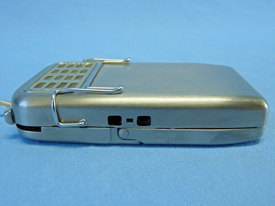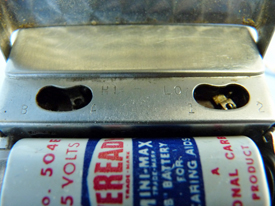Sonotone 1010 Hybrid Hearing Aid
The Sonotone 1010 hybrid transistor hearing aid was manufactured by
Sonotone Corporation of Elmsford, NY. It was the very first hearing aid to use
the newly-developed transistor (not to mention that it was also the very
first commercial application of the transistor). It came out on December 29, 1952. At
that time it sold for $229.50.
The Sonotone 1010 was a hybrid hearing aid as it used
2 vacuum tubes and a single transistor as the output
stage.
This hearing aid represented the
first step in the move from vacuum tubes to all-transistor hearing aids.
The metal case measured 3" by 2¾" by about ½" thick.
It weighed 3.1 oz. (88 g) without the batteries.
|
 |
Click picture for larger view |
| |

|
|
|
|
|
Front view of the Sonotone Model 1010 hybrid transistor hearing aid. Early transistors had problems with their signal-to-noise ratio. As a
result, Sonotone used two vacuum tubes in the first
stages of the circuit, and utilized a transistor in the output stage.
This
combination maintained a high signal-to-noise ration while reducing the
operating current required. This resulted in reduced battery operating costs
for the user.
The problems with the early production transistors were
quickly solved, and most hearing aid manufacturers were producing all-transistor hearing aids by the end of 1953.
As a result, vacuum tube hearing aids
quickly disappeared from the market. This resulted in significant reductions
in battery costs for hearing aid users because the high voltage "B" battery was no
longer needed.
|
 |
Click picture for larger view |
|
|
|
|
Close-up view of the upper front of the Sonotone Model 1010 hybrid
transistor hearing aid showing the microphone grill and the wire pocket
clip below it. Later hearing aids had a 4-pointed star in the center of
the microphone grill.
|
 |
Click picture for larger view |
| |
|
|
Right side view of the Sonotone Model 1010 hybrid transistor
hearing aid. The volume control is at the right.
|
 |
Click picture for larger view |
| |
|
|
Left side view of the Sonotone Model 1010 hybrid transistor
hearing aid showing the optional external microphone jack (two square
holes center). At the left i the on-off switch.
|
 |
Click picture for larger view |
| |
|
|
Top viiew of the Sonotone Model 1010 hybrid transistor hearing aid
showing the volume control (left), the receiver cord plugged in (center)
and the 3-position switch (right). Presumably the 3 positions are off
(down), t-coil (mid) and on (up—shown). |
 |
Click picture for larger view |
| |
|
|
Top view of the Sonotone Model 1010 hybrid transistor hearing aid
showing the receiver cord plug (bottom) and the 2-hole receiver cord
jack (center).
|
 |
Click picture for larger view |
| |
|
|
Rear view of the Sonotone Model 1010 hybrid transistor hearing
aid showing the swing up battery compartment door (bottom half).
|
 |
Click picture for larger view |
| |
|
|
When you swung up the battery door of the Sonotone Model 1010 hybrid
transistor hearing aid, on the inside of the battery door you could see
the name of the manufacturer (Sonotone) and the model number (1010).
|
 |
Click picture for larger view |
| |
|
|
View of the battery compartment of the Sonotone Model 1010 hybrid
transistor hearing aid. The "B" battery fit in the back section and the
"A" battery was at the front. On the bottom of the "A" battery
compartment is a red A+ and a red arrow pointing to the right
indicating the position of the positive terminal of the "A" battery.
|
 |
Click picture for larger view |
| |
|
|
Close-up view of the battery compartment of the Sonotone Model 1010
hybrid transistor hearing aid showing the 15 volt
Eveready 504E "B" battery (rear) and the
Mallory RM-401 (Type "N") 1.4 volt mercury "A" battery (front). |
 |
Click picture for larger view |
| |
|
|
At the rear of the battery compartment of the Sonotone Model 1010 hybrid
transistor hearing aid there were two 2-position switches. The one on
the left is labeled "HI" and has positions "B" and "A". The one on the
right is labeled "LO" and has positions "1" and "2". Presumably they are
for high frequency emphasis and for low frequency emphasis respectively. |
 |
Click picture for larger view |
| |
|
|
Close-up view of the rear wall of the battery compartment of the
Sonotone Model 1010 hybrid transistor hearing aid showing the location
of the positive terminal of the "B" battery (B+), the serial number
(302836) (center) and stamped about the serial number are the words,
"See patent notice in instruction book". |
 |
Click picture for larger view |
| |
|
|
Inside rear view of the
Sonotone Model 1010 hybrid transistor hearing aid showing the
electronics. The battery compartment is at the left. |
 |
Click picture for larger view |
| |
|
|
Inside front view of the
Sonotone Model 1010 hybrid transistor hearing aid showing the two vacuum
tubes (left) and the transistor (marked 1030) (bottom center). The
Germanium Products Corporation made the transistor
used in the Model 1010. The square microphone is at the upper right
and the volume control wheel at the lower right.
|
 |
Click picture for larger view |
| |
|
|
Close-up view of the receiver of the Sonotone Model 1010 hybrid
transistor hearing aid and the receiver cord plug (shown unplugged).
Note that the holes and plug pins are of different diameters so you
could only plug them in the correct way. |
 |
Click picture for larger view |
| |
|
|
Rear view of the receiver of the Sonotone Model 1010 hybrid transistor
hearing aid with the receiver cord plugged in.
|
 |
Click picture for larger view |
| |
|
|
View of the receiver of the Sonotone Model 1010 hybrid transistor
hearing aid showing how the hard plastic ear mold snapped to the nubbin
in the center of it.
|
 |
Click picture for larger view |
| |
|
|
Side view of the receiver of the Sonotone Model 1010 hybrid transistor
hearing aid with the hard plastic ear mold snapped to it. The ear mold
did two things. First, it held the receiver tightly to the ear. Second,
it fit air-tight to prevent any sound escaping from the ear canal which
would cause loud feedback (squealing/whistling sound).
|
 |
Click picture for larger view |
| |
|
|
Here is an excerpt from the March, 1953 issue of Fortune magazine
showing that the Sonotone 1010 was the first hearing aid to ever use a
transistor. If you are interested in the history of Sonotone International,
the maker of Sonotone hearing aids,
Roger Russell has a great website that details its history from its
beginnings in 1929 until its ultimate demise in 2005. There is also a
page giving some information on
some of the Sonotone hearing aids produced. |
 |
Click picture for larger view |
| |
|
|
Here is an excerpt from page 205 of the book, "Crystal Fire: The Birth
of the Information Age" by Michael Riordan, also confirming that the
Sonotone was the first hearing aid to use a transistor. |
 |
Click picture for larger view |
| |
|
|
Here is an advertisement from the Syracuse Herald Journal of December
30, 1952 again confirming that the
Sonotone 1010 was the first hearing aid to use a transistor.
|
 |
Click picture for larger view |
| |
|
|
The Sonotone Model 1010 hybrid transistor hearing aid in its original
case.
The
Sonotone Model 1010 hearing aid, although a hybrid, was awarded the Audio
Engineering Award of Excellence in 1953, even winning over all-
transistor hearing aids. Here is the
report by the judging committee giving their reasoning.
|
 |
Click picture for larger view |
| |
|
|
The Sonotone design on the inside of the lid of the Sonotone Model 1010 hybrid transistor hearing aid
case.
|
|
|
The case of the Sonotone Model 1010 hybrid transistor hearing aid.
The case measured 3⅞ x 3⅞" x 1½" (9.9 x 9.9 x 3.8 cm).
|
 |
|
| |
|
(If a larger picture doesn't appear, you may have to
turn your pop-up blocker off)
|
|
|